Cairngorm and Munth Trout
- Details
- Published on Friday, 27 November 2009 12:30
- Written by Fred Carrie
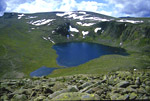 For most people, the Cairngorms need no introduction, but perhaps the reader is less familiar with The Munth.
For most people, the Cairngorms need no introduction, but perhaps the reader is less familiar with The Munth.
The “Mounth”, known to the older folk on Deeside as “The Munth”, is the continuous area of high ground and mountains on the southern edge of the main Cairngorm range, running from
Drumochter in the west to Stonehaven in the east. Nowadays, this entire area is erroneously referred to as the “Cairngorms”. It is not. In fact even “The Cairngorm Mountains” is a blatant example of name changing. The actual name of these hills is An Monadh Ruadh or The Red Hills, just as the proper name of “The Spey Valley” is Strath Spey!
Scots referring to The Thames Valley as Strath Thames would be no more ridiculous, but don’t get me started!
Most people in Scotland are already familiar with this old name, although they may not realise it! The B974 Banchory to Fettercairn “Cairn O' Mount” road is often in the Scottish news. At 1500 feet it is frequently blocked by winter blizzards. The old local name for this road was “The Cairn o’ The Munth”. But is this article about roads or trout?
In Scotland, trout are found in most burns and lochs up to about 2500 feet and sometimes higher. It is fair to say that you will find very few record breakers at these heights, but it is surprising just how fertile some of these lochs can be and the unlikely size of some of the fish that lurk within them. For example, someone I know once caught a fish of about 2lb in the Sandy Loch on Lochnagar above Deeside at 2600 feet and although fish of this size are certainly rare, they are there.
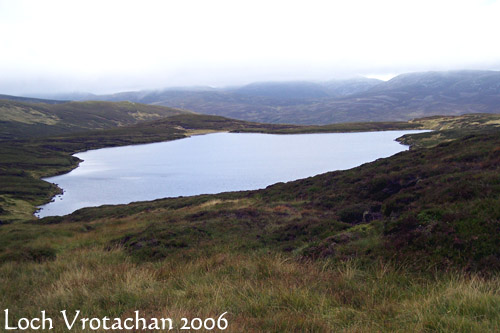 A well known high loch noted for good trout is Loch Bhrot-choin or Vrotachan at 2300 feet behind the “Glenshee” skiing area on the Cairnwell at the head of Glen Clunie. This loch, now fished by Ballater angling club, is fed by streams running off limestone and schist. It is quite fertile. The fish in the loch have a reputation of being very hard to tempt but this can often be the case when the natural feeding is very good. Go up to this loch on a calm summer's day, move a few stones in the waters around the margins and you will be astonished at the life you find, including freshwater shrimps. My only attempts here were on a warm late May day about 30 years ago and a cold September day in 2006. Both times I blanked although I did see fish.
A well known high loch noted for good trout is Loch Bhrot-choin or Vrotachan at 2300 feet behind the “Glenshee” skiing area on the Cairnwell at the head of Glen Clunie. This loch, now fished by Ballater angling club, is fed by streams running off limestone and schist. It is quite fertile. The fish in the loch have a reputation of being very hard to tempt but this can often be the case when the natural feeding is very good. Go up to this loch on a calm summer's day, move a few stones in the waters around the margins and you will be astonished at the life you find, including freshwater shrimps. My only attempts here were on a warm late May day about 30 years ago and a cold September day in 2006. Both times I blanked although I did see fish. 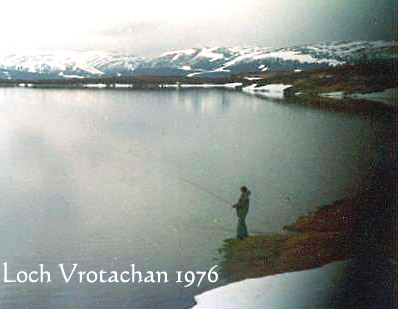 During that first visit the loch was still fringed by snow and was flat calm. Some really big fish were moving and I managed to catch precisely none of them. A friend told me that according to a local keeper, the only time fish are caught in this loch is during very strong winds. I can't vouch for this, but I can certainly tell you when not to catch them and which methods are among the least successful.
During that first visit the loch was still fringed by snow and was flat calm. Some really big fish were moving and I managed to catch precisely none of them. A friend told me that according to a local keeper, the only time fish are caught in this loch is during very strong winds. I can't vouch for this, but I can certainly tell you when not to catch them and which methods are among the least successful.
A few miles further west, beneath Beinn Iutharn Mhor (the great mountain of hell), at about 2600 feet, lies Loch nan Eun (loch of the birds). This loch is full of trout and although I have hiked past it many times at all seasons, I have only fished it three times.
First time was in June 1978, flat calm with rising fish – I blanked (do you detect a pattern emerging here?). Second time was a cold June day in 2004; then I did catch some nice trout up to ¾ lb. The last occasion was a camping / backpacking trip in 2006 during a rare July heat wave, it fished well then too.
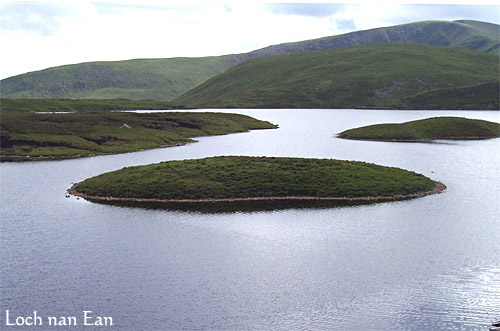 This loch is a long way from anywhere. Getting to it involves a long walk and a killer of a climb. It’s one of these soul destroying climbs. You do know the kind I mean don’t you? You are puffing, sweating and grunting with pain. Your lungs are on the point of bursting and your leg gyrations are the envy of Elvis impersonators everywhere. But you are convinced the loch lies just over that next rise so you push on. Little do you realise, what actually lies beyond that rise is another rise, and another and another. You get the idea? You carry on anyway, what choice do you have? It’s either that or lie down and die.
This loch is a long way from anywhere. Getting to it involves a long walk and a killer of a climb. It’s one of these soul destroying climbs. You do know the kind I mean don’t you? You are puffing, sweating and grunting with pain. Your lungs are on the point of bursting and your leg gyrations are the envy of Elvis impersonators everywhere. But you are convinced the loch lies just over that next rise so you push on. Little do you realise, what actually lies beyond that rise is another rise, and another and another. You get the idea? You carry on anyway, what choice do you have? It’s either that or lie down and die.
The alpine flora of the area testifies that Loch nan Eun is quite fertile. But here is an oddity. The loch is simply moving with shrimp. No, not our native freshwater shrimp Gammarus pulex, rather a grey / blue American species Crangonyx pseudogracilis. Apparently, this shrimp is quite widespread in the UK and Ireland and while it is perhaps easy to understand how they may have spread in rivers, it is less obvious how they arrived at such a high and isolated loch, guarded by high hills and waterfalls on its outlet stream. Perhaps birds were the vector? Who knows? There are certainly quite a lot of common gulls nesting on the islands there. Or were they introduced to improve the feeding and the fishing back in the Victorian sporting heyday? Certainly this loch must have been fished more frequently in the past as old maps do show a boat house on the loch.
From about the mid 19th century up until the first world war, a rivalry existed between many of the old sporting estates. Who had the biggest stags, the most grouse, the highest trout fishing etc. During this period many fish-less high lochs were stocked with trout and surely the one-upmanship trophy for the highest trout fishing in the UK must have gone to the Duke of Fife for his trout at 3050 feet in Loch Etchachan.
In his book "The Highlands of Scotland" the iconic Scottish naturalist the late Seton Gordon, writing in the 1930's, recalls that a boat was moored on this loch for use by anglers. It has long since disintegrated but apparently the mooring ring is still there if you know where to look for it. 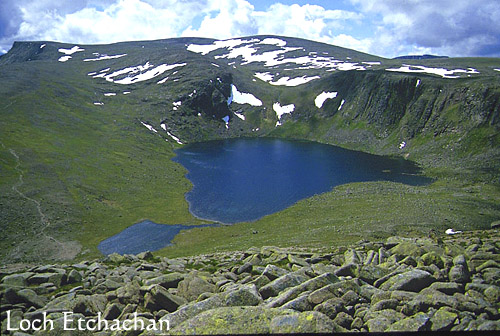 Seton Gordon did say he caught fish there but they were small, dark and thin. This is hardly surprising as the loch lies over granite and the very short cold summers combined with poor fertility may have caused the fish to die out.
Seton Gordon did say he caught fish there but they were small, dark and thin. This is hardly surprising as the loch lies over granite and the very short cold summers combined with poor fertility may have caused the fish to die out.
Apparently, in the late 1960’s or early 1970's fisheries scientist and wild trout enthusiast Niall Campbell put 3000 trout fry into Loch Etchachan, but according to the Watson - Nethersole-Thompson book “The Cairngorms A Natural History”, no one has seen then on subsequent visits. However, I have it from a very reliable source that small trout were caught in Loch Etchachen in the early 1990’s, so it is possible that some of the previous stocking may have reproduced and there may still be fish there now.
The last loch I want to mention is Lochan Uaine (OS map 43 000980) on Ben Macdui. This loch is only a few miles from Loch Etchachan and lies in a cold east facing corrie on the 3200 foot contour. According to information on the Scottish Executive web site this loch holds trout and charr. Now, far be it from me to contradict HM Government or its civil servants, but this must surely be unlikely. The loch is normally ice bound for at least half the year and it is hard to imagine how trout or charr could have got there in the first place unless it was stocked as an experiment. It may of course have been accessible to fish during the immediate post glacial period when disintegrating ice dams held back water and created massive lakes in some areas. Who knows?
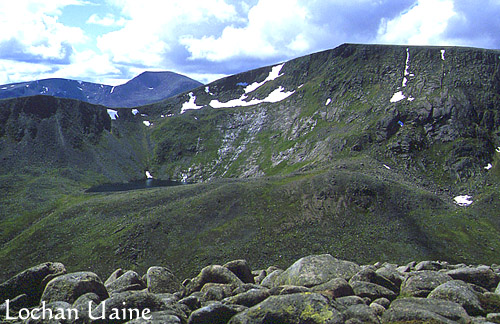 The loch is so hard to get to that it would never be an attractive fishing prospect. A friend of mine once witnessed a devastating slab avalanche here. Masses of snow and rock fell about 800 feet from the cliffs, entered the loch with colossal force on the west side and re-emerged as a tidal wave on the east bank. Any fish in the path of that would not have known much about it. It may be there are fish in this loch. The loch is there for anyone who wishes to conduct experiments.
The loch is so hard to get to that it would never be an attractive fishing prospect. A friend of mine once witnessed a devastating slab avalanche here. Masses of snow and rock fell about 800 feet from the cliffs, entered the loch with colossal force on the west side and re-emerged as a tidal wave on the east bank. Any fish in the path of that would not have known much about it. It may be there are fish in this loch. The loch is there for anyone who wishes to conduct experiments.
Fred Carrie started fishing in the mid 1960's, hillwalking in the 1970's and has been combining the two on and off ever since.
Fred runs the successful Wild Fishing Scotland web site - www.wildfisher.co.uk - and enjoys the hike up to the wild hill lochs as much as the fishing itself. The more uncharitable members of his family and friends say that is perhaps just as well.

